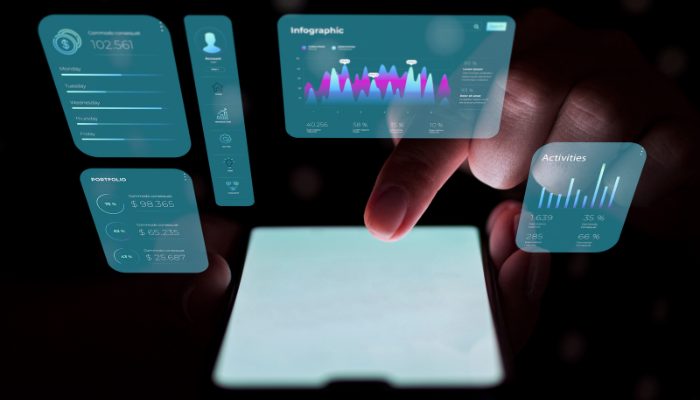Why settle for the ordinary when you can create extraordinary?
In today’s online shopping environment, where shoppers spend an average of 4.1 trillion per visit to online stores, it’s evident that online shopping is the place to be. A storefront that doesn’t just show products but guides your customers through a journey that feels as smooth as swiping through social media, yet has the power to convert clicks into loyal customers. That’s the magic of building with Angular shopping apps—a framework trusted by brands like Nike and McDonald’s for its speed, reliability, and scalability.
In this guide, we’ll talk about creating a digital powerhouse—one that’s tailored to your brand, optimized for speed, and designed to keep shoppers coming back for more. Whether you’re a startup ready to disrupt the market or an established brand looking to scale up, Angular shopping apps can transform your online store from functional to phenomenal.
Ready to make your mark? Let’s get started!
What is Angular?
Angular is a powerful tool that makes web development easier by using TypeScript, which is a step up from JavaScript. TypeScript helps you catch errors early, keeps your code secure, and makes it scalable. With Angular, you can build interactive, single-page applications that feel smooth and engaging for users.
Now, you must be wondering: why consider Angular specifically for building an e-commerce platform? Let’s find out below!
Why Angular is Essential for Modern Web Development?
Angular plays a crucial role in web development by enabling the creation of dynamic, single-page applications (SPAs) that significantly enhance user experience. This makes it an ideal choice for building an Angular shopping app.
Big names like Google, Microsoft, and IBM use Angular, highlighting its reliability in building robust applications. Recent surveys indicate that over 22.96% of developers prefer Angular for creating dynamic applications. Its design incorporates reusable components, dependency injection, and two-way data binding, which streamline development and enhance efficiency when developing complex apps. These aspects contribute to Angular’s popularity among developers seeking to create scalable and maintainable web applications.
Read More: Is Angular Best Used for Frontend or Backend in Your Project?
When it comes to building modern web applications, especially e-commerce platforms, Angular shines in more ways than one. But what makes it stand out for businesses looking to scale and deliver seamless user experiences?
Advantages of Angular Framework for E-commerce Web Applications
Angular isn’t just another framework; it’s built to handle the complexities of e-commerce platforms efficiently. Here are a few reasons why :
Solid Foundation
Angular’s component-based architecture provides a solid foundation for building scalable and maintainable e-commerce applications. By promoting code reusability, Angular simplifies development and management.
Dynamic User Interfaces
Features like two-way data binding and dependency injection empower Angular developers to create dynamic and interactive user interfaces. This is crucial for providing a seamless and engaging shopping experience.
Seamless API Integration
Angular seamlessly integrates with headless e-commerce APIs, such as Commerce Layer. This allows developers to efficiently manage products, orders, and payments while focusing on creating a compelling front-end experience.
Comprehensive Tooling and Support
Angular CLI streamlines project setup and management, making it easier for developers to get started. The extensive documentation and vibrant community provide valuable resources for troubleshooting and learning new features.
Do you lack the right resources or perfect app development tools? Then, look no further. Codewave provides custom software development services to ease your business process. Whether it’s e-commerce platforms, web portals or blockchain applications, we develop it all with 3S of tech, agile and design thinking approach.
Enhanced Security
Angular promotes secure coding practices, helping to protect sensitive customer information. This ensures compliance with industry standards and maintains a trusted online shopping environment.
The team at Codewave specializes in using powerful frameworks like Angular to build dynamic and secure e-commerce platforms. Whether you’re aiming to create a seamless shopping experience or scale your online business, Codewave can help you achieve your goals.
So, how does this all play out in the real world? Let’s take a look at some companies that have successfully used Angular to power their e-commerce platforms.
Companies Using Angular for E-Commerce
Companies across industries rely on Angular to build fast, reliable e-commerce platforms. Its speed, scalability, and real-time updates make it a top choice for brands like Nike, McDonald’s, and Best Buy, enabling them to handle high traffic and deliver smooth shopping experiences. Let’s look at it in detail!
1. Nike:
One of the world’s largest athletic brands, Nike, leverages Angular to create a dynamic and interactive e-commerce experience. With real-time inventory updates, personalized product recommendations, and smooth checkout processes, Angular helps Nike manage its high traffic while delivering an exceptional user experience.
2. McDonald’s:
The fast-food giant uses Angular to power its online ordering system, efficiently handling thousands of orders every minute. Angular’s efficient data handling and real-time updates ensure a seamless ordering experience, even during peak hours.
3. Best Buy:
As a leading electronics retailer, Best Buy employs Angular to create a fast, responsive, and scalable shopping app that effortlessly handles millions of products and customers.
These examples demonstrate how Angular can handle the demands of even the largest e-commerce platforms, making it the perfect choice for your Angular shopping app.
These examples prove that when it comes to e-commerce, even the biggest brands trust Angular to deliver a smooth, reliable experience. Now, it’s your turn to create something amazing!
Also Read: Angular App Creation: A Beginner’s Guide to Building Your First Project
Now that you’ve got a sense of Angular’s impact. Let’s get into setting up your Angular e-commerce project from scratch. Ready? Let’s go!
Setting Up Your Angular E-commerce Project Step-by-Step
Let’s get hands-on and start building your Angular shopping app from scratch.
Step 1: Prerequisites
Before you begin, ensure you have the following tools installed:
- Node.js: The runtime environment for running JavaScript on the server side.
- npm: The package manager with Node.js is used to manage dependencies.
Step 2: Install Angular CLI
The Angular CLI is a powerful command-line tool designed to streamline the process of creating and managing Angular projects. With a single command, you can quickly generate a new Angular application:
| npm install -g @angular/cli |
- To manage subscriptions effectively and prevent memory leaks, you can use the ngx-until-destroy library. Install it with npm:
| npm install ngx-until-destroy |
Step 3: Create and Test the Angular App
With the basics in place, it’s time to get your Angular application up and running:
- Creating the App: As mentioned earlier, use the ng new command with the –routing flag to set up your project structure and essential files.
- Testing: The Angular CLI includes a development server for local testing. Start it with the following command:
| ng serve |
Step 4: Building Angular Components
Angular components are the building blocks of your e-commerce UI, acting as reusable widgets. Let’s start by creating a homepage component and a single product component.
- Creating a Homepage Component: Use the Angular CLI to generate a homepage component with this command:
| ng generate component homepage |
- In the homepage.component.ts file, define properties for the app title and subtitle:
| export class HomepageComponent { appTitle = ‘Your Store Name’; subTitle = ‘Welcome to your one-stop shop!’; } |
- In the corresponding homepage.component.html file, add HTML templating to display these properties:
| <h1>{{ appTitle }}</h1> <p>{{ subTitle }}</p> |
Step 5: Creating a Product Page Component with Angular Routing
An e-commerce website has several key features. Here’s a breakdown of how to implement the main functionalities:
a. Product Listing
- Create a Product Model: Define an interface for product data:
- Product Service: Create a service to handle product data:
- Product Listing Component: Use the service to fetch and display a list of products
b. Shopping Cart
- Cart Service: Create a service to manage cart operations like adding, removing, and retrieving items:
| import { Injectable } from ‘@angular/core’;import { BehaviorSubject } from ‘rxjs’;import { Product } from ‘./product.model’; @Injectable({ providedIn: ‘root’,})export class CartService { private cartItems = new BehaviorSubject<Product[]>([]); cartItems$ = this.cartItems.asObservable(); addToCart(product: Product) { const items = this.cartItems.getValue(); items.push(product); this.cartItems.next(items); } getCartItems(): Product[] { return this.cartItems.getValue(); } removeItem(productId: number) { const items = this.cartItems.getValue().filter(item => item.id !== productId); this.cartItems.next(items); }} |
c. User Authentication
- Use Angular’s HttpClient for interacting with backend authentication APIs (e.g., JWT-based authentication).
- Implement login and signup forms, and store tokens securely (e.g., in localStorage).
- Create guards to protect routes that should only be accessible to logged-in users:
d. Checkout and Payment Integration
Run the following command to create the cart service:
| ng generate service cart |
This command generates a cart.service.ts file, where you can define properties and methods for managing cart items.
Step 6: Define Properties and Methods in cart.service.ts
Open the generated cart.service.ts file and set up properties and methods to handle cart operations like adding items, removing items, getting the current cart items, and calculating totals.
Here’s an example of a basic implementation:
| import { Injectable } from ‘@angular/core’;import { BehaviorSubject } from ‘rxjs’;import { Product } from ‘./product.model’; // Make sure to import your Product model @Injectable({ providedIn: ‘root’,})export class CartService { // BehaviorSubject is used to keep track of the cart’s state. private cartItems = new BehaviorSubject<Product[]>([]); cartItems$ = this.cartItems.asObservable(); constructor() {} // Method to add a product to the cart addToCart(product: Product): void { const currentItems = this.cartItems.getValue(); const itemIndex = currentItems.findIndex(item => item.id === product.id); // Check if the product already exists in the cart if (itemIndex > -1) { currentItems[itemIndex].quantity! += 1; } else { // If the product is new, add it with an initial quantity of 1 product.quantity = 1; currentItems.push(product); } this.cartItems.next(currentItems); } // Method to remove a product from the cart removeFromCart(productId: number): void { const updatedItems = this.cartItems .getValue() .filter(item => item.id !== productId); this.cartItems.next(updatedItems); } // Method to update the quantity of a cart item updateCartItemQuantity(productId: number, quantity: number): void { const currentItems = this.cartItems.getValue(); const itemIndex = currentItems.findIndex(item => item.id === productId); if (itemIndex > -1) { currentItems[itemIndex].quantity = quantity; // Remove the item if the quantity is zero or less if (currentItems[itemIndex].quantity! <= 0) { this.removeFromCart(productId); } else { this.cartItems.next(currentItems); } } } // Method to get the current list of cart items getCartItems(): Product[] { return this.cartItems.getValue(); } // Method to clear the cart clearCart(): void { this.cartItems.next([]); } // Method to calculate the total price of items in the cart getTotalPrice(): number { return this.cartItems .getValue() .reduce((total, item) => total + item.price * (item.quantity || 1), 0); } // Method to get the total quantity of items in the cart getTotalQuantity(): number { return this.cartItems .getValue() .reduce((total, item) => total + (item.quantity || 1), 0); }} |
To integrate payment gateways like PayPal into your Angular application, follow their specific instructions and APIs. This process generally involves creating an account with the chosen payment gateway and utilizing their SDKs or APIs to manage payments within your app. While the exact steps may vary based on the gateway, the general process includes:
- Include the Payment Gateway’s SDK: Add the JavaScript SDK provided by the payment gateway to your Angular application.
- Create a Checkout Component: Design a checkout component where users can securely enter their billing and shipping information.
- Process Payments via API: Use the payment gateway’s API to process transactions securely once the user confirms their order.
By following these steps, you can seamlessly integrate payment processing into your Angular application.
Step 7: Backend API Integration
Angular is a front-end framework, so it needs to connect to a backend for data. You can use technologies like Node.js with Express, Django, or any backend that supports REST APIs. Ensure the backend provides endpoints for:
- Fetching products and categories.
- Managing user authentication (login, signup).
- Handling cart and order processing.
Step 8: Testing and Deployment
Testing ensures that your application functions as expected:
- Unit Testing: Use Angular’s built-in testing tools like Karma and Jasmine for unit tests.
- E2E Testing: Use Protractor for end-to-end testing, simulating user interactions.
Deployment options include:
- Hosting on Firebase: Angular apps integrate well with Firebase hosting:
| ng add @angular/fireng deploy |
- Using AWS or Azure: Host your app on cloud platforms using services like S3 (for static files) and Lambda (for serverless backend).
Codewave’s QA testing guarantees a bug-free and seamless website experience! We meticulously resolve any issues before launch, ensuring a smooth start and satisfied customers from day one.
Let’s make sure your grand opening is a resounding success!
Step 8: Optimizing for Performance
To ensure a smooth user experience, focus on:
- Lazy Loading: Load modules only when needed using Angular’s lazy loading feature.
- AOT Compilation: Use Angular’s Ahead-of-Time (AOT) compilation to improve performance.
- Caching: Utilize browser caching for static assets and implement HTTP caching strategies for data requests.
Building an e-commerce website with Angular involves a balance of front-end design, backend integration, and user-focused functionalities. With Angular’s robust tooling and architecture, you can build a site that is responsive, secure, and optimized for performance, providing an excellent user experience.
Optimize your Angular project for top performance with Codewave’s expertise in web app development and cloud infrastructure. Using tools like Angular for server-side rendering. Our use of AWS and Google Cloud for containerization allows us to build scalable, resilient solutions. What sets Codewave apart is our focus on Progressive Web Apps (PWAs), tailored microservices architecture, and continuous performance monitoring—all designed to give your app the edge it needs. Let’s build a solution tailored to your specific needs.
Also Read: Building a Progressive Web App with Angular by Codewave 12 minute read
Now that you know the structure, let’s address a common challenge: handling Angular CLI errors with some quick fixes.
Troubleshooting Angular CLI Errors: Simple Solutions for Beginners
When you’re starting out with Angular, running into errors in the Angular CLI is pretty common. But don’t stress—most problems have straightforward fixes. Here are a few easy ways to get past them:
1. Keep Your Dependencies Updated
Conflicts often arise from outdated packages. Running npm update will help keep everything up-to-date. If you’re still facing issues, try removing the node_modules folder and reinstalling with npm install. This can often resolve version mismatch problems.
2. Verify File Names and Paths
Even small errors like typos in file names or incorrect paths can cause your build to fail. Go over your file names, paths, and import statements to ensure there are no mistakes.
3. Clear Cached Files
Sometimes clearing your cache can fix unexpected issues. Use commands like npm cache clean –force or ng cache clean to remove any corrupted files that may be causing the error.
4. Examine Error Messages Closely
Error messages from the Angular CLI can be very helpful, so don’t skip reading them. Focus on the first error mentioned—it’s usually the key to solving the problem.
By following these steps, you can quickly troubleshoot Angular CLI errors and continue building your app with ease.
Why Trust Codewave for Building Your Angular E-Commerce Web App?
Codewave is a Design Thinking Led Digital Innovation Company that helps businesses craft exceptional web experiences. At Codewave, building an Angular e-commerce web app is more than just choosing the right framework—it’s about crafting an experience that meets your business objectives and exceeds your customers’ expectations. Using Angular as our preferred framework, we develop e-commerce platforms that are fast, scalable, and designed to drive conversions.
Here’s how we make a difference:
Professional Expertise in Angular
Our team has deep expertise in Angular, allowing us to fully leverage its capabilities to create powerful e-commerce applications. From seamless navigation to dynamic product displays, we ensure your platform is optimized for a smooth shopping experience, turning visitors into loyal customers.
At Codewave, we offer a wide range of Angular development Solutions to cater to your specific needs. Here are just a few of the services we provide:
- Custom Angular Development
- Interactive Web Experiences with Angular
- Angular Mobile App Development
- Angular Single Page App (SPA) Development
- Angular API Development
- Angular Migration
- Angular Plugin Development
- Progressive Web App (PWA) Development
Customized Solutions for Your Business
Every e-commerce business has unique needs, and we don’t believe in one-size-fits-all solutions. Whether you want to enhance user engagement, improve loading speed, or offer personalized shopping experiences, we tailor your Angular e-commerce web app to meet these specific goals, helping your brand stand out in a competitive market.
User-Centered Design Approach
We integrate design thinking into our development process, ensuring that your app is not only feature-rich but also intuitive and user-friendly. We take the time to understand your customers’ needs and pain points, designing interfaces that keep users engaged and satisfied throughout their shopping journey.
Focus on Performance and Scalability
We understand that as your business grows, so will the demands on your web app. That’s why we build e-commerce platforms that are optimized for high performance and can easily scale as your user base expands. Whether you’re handling a few orders a day or preparing for peak traffic during sales, your app will remain responsive and efficient.
Proven Success Across E-Commerce Industry
Our portfolio includes a range of successful e-commerce projects, from niche online stores to large-scale marketplaces. We’ve helped businesses achieve significant results, from reducing cart abandonment rates to increasing page load speed and improving customer retention.
Conclusion
E-commerce development is booming worldwide, making this the perfect time to build an e-commerce web application with Angular. The future looks promising for Angular-based e-commerce, as more consumers and clients are increasingly turning to online platforms for their purchasing needs. Investing in Angular for e-commerce now can set you up for significant growth and profitability in the coming decade.At Codewave, we build platforms that deliver speed, engagement, and sales growth. Ready to transform your online business? Let’s connect.
Codewave is a UX first design thinking & digital transformation services company, designing & engineering innovative mobile apps, cloud, & edge solutions.







